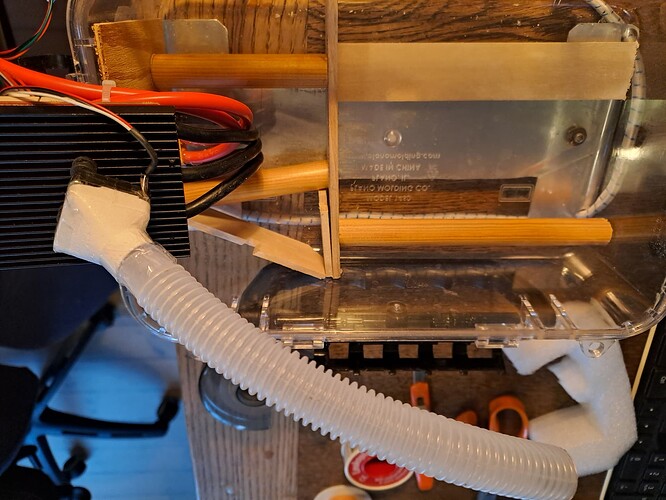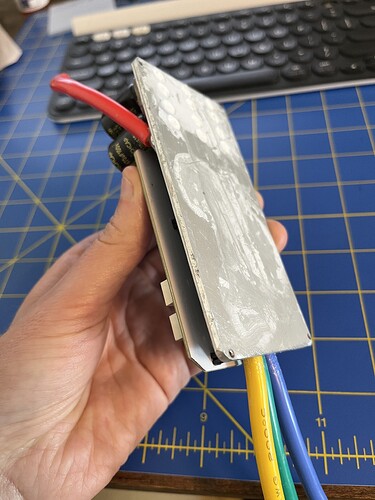Appreciate the advice, I would rather overbuild than underbuild, so I’ve ordered the 75200 v2 pro. Any thoughts on a 3D-printed prop versus buying aluminum? 2-blade vs. 3-blade folding?
I’m not sure about prop choice for your motor although lots of posts here about.
From my perspective however it would seem reasonable that you start with a good non folding three blade as that would provide predictable low end thrust as you will likely be doing a lot of starts while learning.
I put all together in one waterproof box. Batteries on bottom ESC on top. If you do a lot of starts from zero you will get a hot box, but your total riding time is reduced anyway too. When you are more experienced and do maybe 2 to 3 water starts the total currents and thus heat dissipation gets kind of low. I also did not add a BMS but I added temperature sensors to my batteries. The VESCs typically also got a temp sensor built in and I think it was 80° where they kind of reduced power. So you dont want to get in this temperature zone.
So Chris, no hole cut in the box for the radiator fins to be cooled from outside air, nice. That sounds like good thermals. Glad you mentioned your heating issues before I went with the 75100. I wonder if a fan in the box would help with cooling or if moving hot air across the vesc would essentially do nothing
I have a fan on the ESC in the box. It helps a little. I was still experiencing temperature-based cut-off. A hose and air guiding around in the box improved the effect. Now the (ESC) temperature reaches 70c and no problems.
I have both of those and run both of those. I use the 75100 on my assist setups with the 6364 and 6384. Its never exceeded 80A (battery current) and once up tends to run about 20A unless I start carving heavily under power. I should also state that I was using a 24L board and am 95kg. I never had it overheat and out of all the components the battery was the warmest.
The 75200 I run on efoil. I’ve been lazy and haven’t bothered water-cooling it but its not overheated yet. The only thing I can say is that I havent been hammering the trigger like a used to a few years back.
heat sink on the side of the box with ESC glued through a hole is probably the easiest fix to any temperature issues. Without, I had ESC hitting high 90s, and once done cool to the touch, easy and effective
What did you use to waterproof the cut-through for the esc cooling? Has the system held up over time. Any reapplying of glue/epoxy needed or all still watertight?
Another way to cool an ESC is to add a liquid like CorrosionX or mineral oil or something similar to slosh around in the box. I have seen a few examples of this approach.
It’s a pretty simple way to help manage heat build up, but I imagine it’s messy when something goes wrong you go into the box and get things out.
I would personally lean towards the cut out method with an external heat sync glued onto the box. Probably with 3M 5200 marine adhesive and maybe some silicone as well around the edges.
This is a (dead) 75200 vesc removed from its outer casing. I would press the lower aluminum plate against the heat sync with a bit of thermal paste or glue. The outer case would be nothing but bulk and weight and would reduce the effectiveness of the outer heat sync. If thermal paste is used then some sort of clamp or screws would be needed to hold it in place (if it separates from the heat sync it will heat up and die).
Interesting. Last night my son was showing me desktop computers immersed in mineral oil as a cooling solution. I’m guessing it’ll be heavy to have the battery box filled with mineral oil, but a custom aluminum box just large enough to hold the vesc outside the battery box might be a good option. If backpack builds have any heat issues, this might be good. Anyone built a backpack assist/efoil and have any issues with overheating?
See an example of that in this thread
The backpack idea has been around for a year or two but I don’t recall seeing anyone post many details of a successful build. I know there are a couple people who have done it with some success but they haven’t taken the time to post much. It’s the least represented form factor on the forum.
For the oil solution, I don’t think you need to fill the box, just 2-3cm of it sloshing around the bottom
Not trying to dampen your enthusiasm but you started this thread asking for critique so you have left yourself open😉
You seem to trying to incorporate a very diverse set of approaches into a single build. It might work out but you might spend a lot of time trying to address things once you get it going.
From what I understand you are starting out full efoil (powered all the time with the motor) with what is a small motor and battery for that type of foiling so you will not have much time on the water before you need to recharge or swap battery for a spare.
Then you want to foil assist with same setup (use motor to catch wave etc). You have a relatively big board and foil to pump so you are dependent on battery and motor and you might find that rig challenging to handle in sizeable waves.
You are now expressing interest in a backpack build. This type seems to be more for someone who has advanced wave foiling and some pumping skills and only use minimal motor power for their session. They are after a feeling of pure (non motor assisted) riding.
It’s great to consider and investigate all the options and I applaud you for that but at some point I think it would be prudent to settle on a foil method for your first build and build a rig that will optimize your experience. ![]()
You’re totally right to call me out, I may be asking for something that might not be possible. My thoughts were that this setup could be used:
- on my bigger board for short efoiling sessions for about 20mins (max of 30 mins) like the foil assist+.
- then transition it to more of a foil assist use (first on the same large board and then moving to a smaller board)
- the backpack idea may be too much to consider right now, I was just curious if this build might be able to transition to a backpack. It would be cool to move the weight off the board for a more natural feel of the board and foil.
However, maybe it’s too optimistic to think it’s even posible that this system could work as a jack of all trades. I’ve seen @Jezza (pretty much my exact weight) mention he is able to go out on a pretty small board. He obviously has experience and skill that I don’t, but I’m hoping I don’t outgrow my first build too quickly once I get a bit of time under my belt. Maybe it’s inevitable that I’ll want dedicated builds.
A backpack is very simple, along with “box on board” are possibly simplest options,
Marine sealant for the heatsink to box, and thermal paste for heatsink to ESC. It seals very well with very little chance of leak, just make sure the heatsink to box interface is an inch wide or more.
Here is a picture, high quality marine sealant better than epoxy I think for heat cycles (advice from someone here)
.Tips for mounting Flycolor x-Cross 120A - #5 by Jesserosco
Hey Jezza! Got a quick question been stumped on this issue for awhile now on my build. Using a similar setup too Tolson with
Flipsky 6384 waterproof 140kv motor
Flipsky 75100 pro v2 VESC
Flipsky VX3 pro remote
10s 4p pack with samsung 30T
and I’ve built my own board and wingset but having some issues with the power delivery.
Have you noticed any issues with under performance on your setups? I’ve tested with some different 3d printed props but current draw stays around 20 amps on the vx3 remote fully submerged at full throttle. When I have it half way out of the water it’ll get too 40-50amps. When I plug in the VESC into a laptop it shows something like 50-60 amps regardless of being fully submerged or not so not entirely sure what’s happening. Possibly reading the phase amps on the vx3? Curious if you might have any insight into why this could be happening. Seems like severly underpowered for the setup, barely moving at 3-5 mph when I’m “boogie boarding” it.
Thanks! Josh
Not enough phase amps to get enough torque.
This is why your battery current stays low, because of low RPM and low duty cycle.
Set battery amps to 100 and phase amps to 150. Then see what happens.
I trust you’ll have it all sorted by the time by vesc arrives ![]()
I was able to get my setup out today for about 20 seconds before my remote lost reception. No blue light at all on my receiver (in the box) and no bar even showing on the remote. ANy idea what would have blown the reciever? Or maybe there’s a reset?

